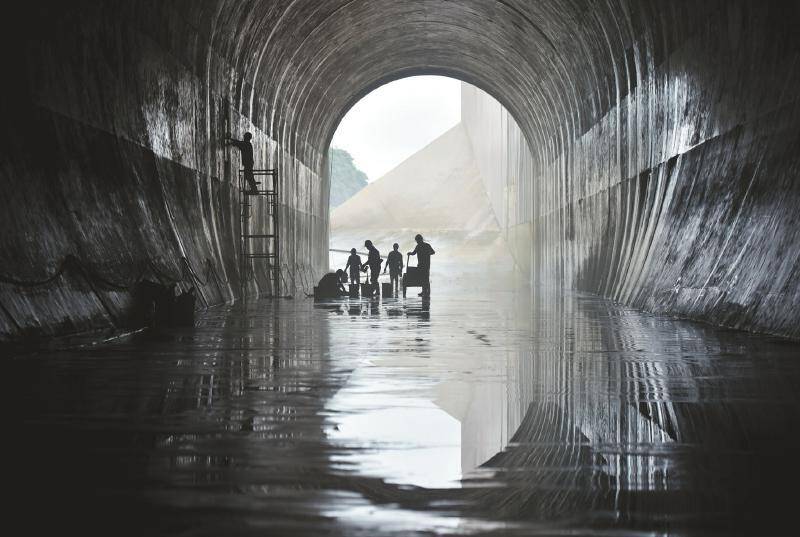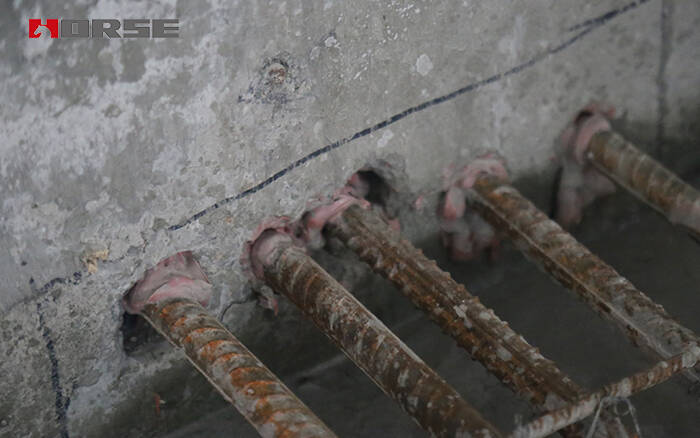Flood-discharge Tunnel Strengthening
The Application Of Planting-bar Technique In Flood-discharge Tunnel Strengthening Engineering
The Application Of Planting-bar Technique In Flood-discharge Tunnel Strengthening Engineering

The spillway tunnel is one of the important components of the reservoir building. The upper head, the four walls and the lower head of the spillway tunnel have been partially damaged under the long-term action of the flood flow, and the surface of the structure has formed defects such as pitted surface. The concrete on the original surface of the structure is carbonized seriously, which affects the service life of the building.
The tunnel to be reinforced is located in the Taigong Mountain Scenic Area, Tianmu Lake Tourist Resort, Liyang National AAA Scenic Area, and is one of the seven large reservoirs in the Taihu Lake Basin. The reservoir has a catchment area of 148.5km2 and a total storage capacity of 108.6 million m3. It is a large reservoir. The designed flood level is 23.00m, and the normal storage level is 21.00m. It was built in the 1950s. After decades of operation, denudation and pitting appeared on the concrete surface of the cave head and wall. The first gate of the upper cave is severely corroded, and the door slot and the access door slot have been damaged to varying degrees, which has affected the normal use of the reservoir's flood discharge, and it needs to be reinforced to eliminate hidden dangers. The reinforcement treatment of the upper tunnel combined the characteristics of the project in a scenic tourist area, and the bent frame, pedestrian bridge, working bridge and hoist room above the original 23.0m pier wall were all demolished.
In the selection and design of the reinforcement scheme, considering the practicality, feasibility and economy, the HORSE injection anchor epoxy glue was finally selected to thicken and strengthen the original concrete structure of the upper tunnel. The outer surface of the original pier wall is roughened and replanted bars are re-poured into concrete, the pier wall and bottom plate are thickened, and the bent frame and working bridge are re-poured by planting bars on the top of the pier wall. This reinforcement project has achieved the expected results.

1 Characteristics of injection anchoring adhesive
The injection anchoring adhesive is a two-component high-strength composite resin structural glue, which has the characteristics of strong anchoring force, fast curing speed, simple construction and low material cost. Fast curing speed, fast curing at room temperature after reconciliation, fast load-bearing to the building structure, strong anchoring force, good heat resistance, and no creep at room temperature. Good anti-aging and medium resistance (acid, alkali, water) performance, welding resistance, flame retardancy, airtightness, moisture resistance, shock resistance, good process performance, can be constructed under the environment of minus 10℃~+40℃ (See Table 1).

| Operable time and curing time | |||||
| Ambient temperature(℃) | -5 | 0 | 10 | 20 | ≥30 |
| Operable time(℃) | 60 | 45 | 30 | 25 | 20 |
| Curing time(h) | 72 | 48 | 24 | 12 | 6 |
2 Construction method
1.Drill hole to the diameter and depth required. The diameter must be in accordance with anchor size.
2.The drill hole must be cleaned with air blower, starting from the bottom of the hole.The drill hole mustbe thoroughly cleaned with steel brush. After brush, to use air blower to clean the drill hole again.
3.Inject HM-500 epoxy anchoring into the hole, starting from the bottom, while slowly drawing back the static mixer. In any case avoid entrapping air. For deep holes extension tubing can be used.
4.Insert the anchor with a rotary motion into the filled drill hole. Some adhesive must come out of the hole.
5.During the resin hardening time the anchor must not be moved or loaded.
Video of Horse HM-500 Injectable Anchoring Adhesive(click it)
3 Reinforcement test results
After the construction of the planting bars is completed, the anchoring force shall be tested after all the anchoring adhesive have solidified. The test is based on the JGJ145-2004 Technical Regulations for Post-Anchoring of Concrete Structures.
4 Conclusion
According to the reinforcement effect of this project, we realize that as long as the anchoring steel bars are constructed in accordance with the corresponding construction technical requirements, the performance of the anchoring steel bars can meet the design requirements, which is technically feasible and convenient for construction. The economy is fully embodied in the application of reinforcement projects, and it provides experience for similar projects in the future.